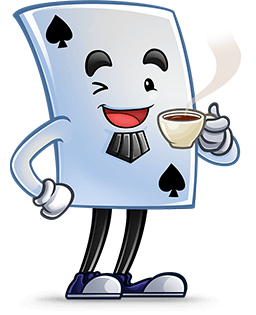Pyramid Solitaire Objective
The goal of Pyramid Solitaire is to clear the tableau by pairing two exposed cards whose total add up to 13.
Number cards are their face value, while aces are 1, jacks are 11, queens are 12, and kings are 13.
Our version is a relaxed variation because it allows you to win the game even if cards are left in the
stockpile.
How to Play Pyramid Solitaire
This Solitaire card game has four distinct areas dealt with a standard 52-card deck.
-
Tableau: The pyramid-shaped tableau consists of 28 playing cards in seven rows, starting with one
card at the top and increasing to seven cards at the base. Each card in rows two through seven overlaps
cards from the previous row, and only exposed cards (those with no cards overlapping them) are playable.
-
Stockpile: The 24 remaining cards make up the stockpile, which is placed facedown below the tableau.
You can draw from it when you get stuck. However, you can only run through the stockpile once.
-
Waste pile: Flip a card from the facedown stockpile to the face-up waste pile when you run out of
moves. The top card of the waste pile can be used to pair with cards in the tableau.
- Foundation pile: Pairs of cards that add up to 13 are placed in the foundation pile.

Now that you understand the setup, let’s dive into the Pyramid Solitaire rules that guide gameplay.
-
Pair cards that add up to 13. For example, you can pair an eight and a five or a jack and a two. The
only exception is a king, which can be moved as a single card to the foundation pile without pairing since
it has a value of 13 on its own.
-
Only play exposed cards. You can match cards within the tableau or a tableau card and a waste pile
card as long as the two cards are exposed, meaning that they aren’t overlapped by another card. At the
beginning of the game, cards in the bottom row and the face-up card in the waste pile can be paired.
-
Draw from the stockpile as needed. If there aren’t more pairing options, flip a card from the
stockpile to the waste pile. The new top waste pile card can now be used for pairing.
-
Only run through the stockpile once. You can only go through the stockpile once unless you’re playing
Easy Pyramid Solitaire, in which you can run through the
pile twice. If you’ve flipped all the stockpile cards into the waste pile and haven’t cleared the tableau,
you lose the game.

Pyramid Solitaire Strategies
Pyramid Solitaire rules are easy enough, but if you’re new to the game you may find yourself getting stuck. You
can try these strategies to increase your chances of winning and use the undo button if you make a wrong move.
- Play kings immediately. Since kings equal 13, they don’t require a pairing card to remove.
-
Avoid using the stockpile unless necessary. Since you can only run through the stockpile once, you
don’t want to flip cards unnecessarily. Play the tableau and waste pile until you get stuck.
-
Prioritize pairs in the tableau. If you have the option between pairing a waste pile card and tableau
card or two tableau cards, choose the latter since the goal is to clear the tableau.
-
Prioritize pairs that uncover the most cards. If you have the option between removing a card that is
covering one card and a card that is covering two cards, choose the card covering two cards to give you more
cards to work with.
-
Remove cards from the tableau evenly. This prevents cards from getting buried. If one side has
significantly more cards than the other, it can be difficult to clear the deeper side later in the game.
If you enjoy Solitaire games, we offer plenty of free options, including
Classic Solitaire,
Spider Solitaire,
Tri Peaks, and FreeCell.
Try a new game today! No downloads or registration required.




